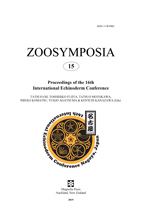Abstract
Recent studies have shown that micro-computed tomography (µCT) must be considered one of the most suitable techniques for the non-invasive, three-dimensional (3D) visualization of metazoan hard parts. In addition, µCT can also be used to visualize soft part anatomy non-destructively and in 3D. In order to achieve soft tissue contrast using µCT based on X-ray attenuation, fixed specimens must be immersed in staining solutions that include heavy metals such as silver (Ag), molybdenum (Mo), osmium (Os), lead (Pb), or tungsten (W). However, while contrast-enhancement has been successfully applied to specimens pertaining to various higher metazoan taxa, echinoderms have thus far not been analyzed using this approach. In order to demonstrate that this group of marine invertebrates is suitable for contrast-enhanced µCT as well, the present study provides results from an application of this technique to representative species from all five extant higher echinoderm taxa. To achieve soft part contrast, freshly fixed and museum specimens were immersed in an ethanol solution containing phosphotungstic acid and then scanned using a high-resolution desktop µCT system. The acquired datasets show that the combined visualization of echinoderm soft and hard parts can be readily accomplished using contrast-enhanced µCT in all extant echinoderm taxa. The results are compared with µCT data obtained using unstained specimens, with conventional histological sections, and with data previously acquired using magnetic resonance imaging, a technique known to provide excellent soft tissue contrast despite certain limitations. The suitability for 3D visualization and modeling of datasets gathered using contrast-enhanced µCT is illustrated and applications of this novel approach in echinoderm research are discussed.

